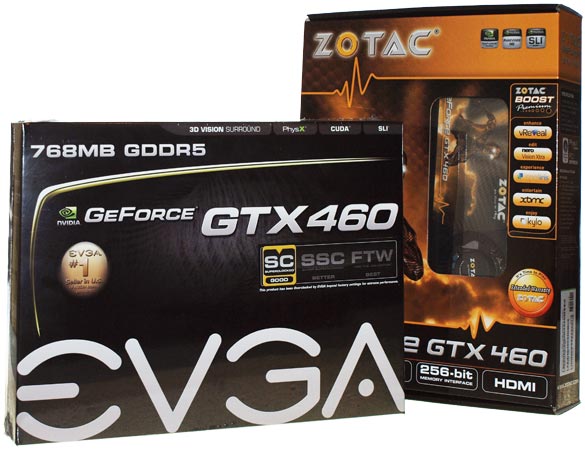NVIDIA GeForce GTX 460 Debut: ZOTAC, EVGA
The road leading up to the release of their Fermi architecture-based GF100 GPU, which powers the first wave of GeForce GTX 400 series cards, was a rocky one for NVIDIA. Hampered by a number of delays, and design and manufacturing issues, the GF100 hit the scene much later than NVIDIA would have liked. Since the initial arrival of the flagship GeForce GTX 480 and its sibling the GeForce GTX 470 a few months back, however, NVIDIA has expanded their GF100-based graphics card line-up to include a third family member, the more mainstream GeForce GTX 465. Of course, all three cards are widely available now.
Today, NVIDIA is unleashing yet another Fermi-architecture based graphics card, but unlike its predecessors, this one isn't based on the GF100. The GeForce GTX 460 we'll be showing you today is actually based on a new-class of Fermi-based GPU, the GF104. The GF104 borrows heavily from the GF100 design, but it features fewer CUDA cores and is pared down in a couple of other areas as well. In fact, it features over a billion fewer transistors than the GF100. Overall though, as you'll see on the pages ahead, the new GeForce GTX 460 is surprisingly potent given its relatively affordable price point and scaled down GPU.
Take a gander at the specifications and features of the two GeForce GTX 460 variants being introduced today directly below, and then we'll move on to show you some retail-ready cards from ZOTAC and EVGA, complete with a full battery of performance tests on both, along with some competing cards from the AMD camp...

|
As you can see in the specifications above, there are two GeForce GTX 460 cards hitting the scene today, a 768MB model and a 1GB model. If you look more closely though, you'll see that the cards actually differ in a few other meaningful ways as well. For example, the 768MB card features a smaller L2 cache, a narrower memory interface, and 8 fewer ROP units. We'll show you how these differences affect performance a little later on in the article, but the most obvious difference is that the 768MB model offers less peak memory bandwidth, which will obviously impact performance in bandwidth bound situations. Other than the items we've mentioned, however, the two GeForce GTX 460 cards are nearly identical in terms of their specifications.

Before we show you the actual cards, we should probably talk a bit about the GF104 GPU at the heart of the GeForce GTX 460. The GF104 is manufactured using TSMC's advanced 40nm process, and features 1.95 billion transistors--the GF100 features over 3 billion. In the configuration powering the GeForce GTX 460, the chip sports 2 graphics processing clusters, 7 streaming multiprocessors, 336 CUDA cores, 56 texture units, and 24 (768MB card) or 32 (1GB card) ROPs. It also sports a 256-bit memory interface, which can obviously be scaled back by disabling channels.

Each of the streaming multiprocessors in the GF104 GPU features 48 CUDA cores, 8 texture units, various registers and cache, and its own PolyMorph engine. You can see each functional block outlined in the diagram above. What you'll also notice is that the GF104 is actually comprised of 8 streaming multiprocessing units, so there's a possibility for more powerful cards based on this GPU design at some point in the future.









